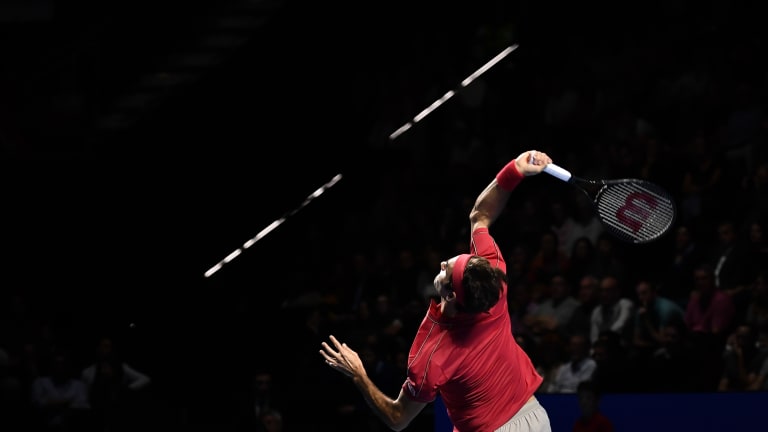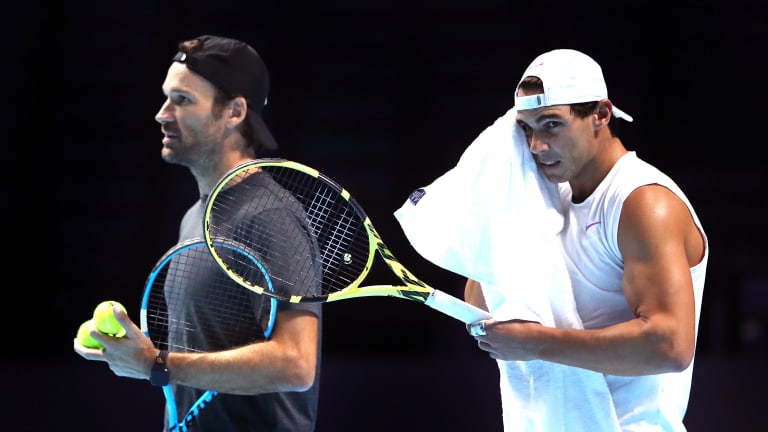The role of analytics in tennis is on a long, slow rise
By Kamakshi Tandon Jan 17, 2020Reaction to Roger Federer's Hall of Fame induction: "You're the most important sportsman of all time"
By TENNIS.com Nov 20, 2025Roger Federer is headed to the International Tennis Hall of Fame: 26 stats for his 2026 induction
By John Berkok Nov 19, 2025Mary Carillo joins Roger Federer with election into International Tennis Hall of Fame
By Associated Press Nov 19, 2025Jannik Sinner has now reached the final at all four Grand Slams and the ATP Finals this year
By John Berkok Nov 15, 2025Carlos Alcaraz, Jannik Sinner take their rivalry—and star power—on the road for 2026 “Super Match”
By Stephanie Livaudais Oct 24, 2025Roger Federer thrills tennis world with Shanghai Masters Celebrity doubles return
By David Kane Oct 10, 2025Roger Federer kicks off court speed debate: are fast courts going extinct?
By Pete Bodo Oct 09, 2025Roger Federer, Juan Martin del Potro lead 2026 nominees for the International Tennis Hall of Fame
By Associated Press Oct 01, 2025“With that swing…” Roger Federer teases Rafael Nadal in Ryder Cup video message
By Stephanie Livaudais Sep 27, 2025The role of analytics in tennis is on a long, slow rise
While tennis doesn't just involve numbers, it is increasingly being measured in them.
Published Jan 17, 2020
Advertising
Tennis has never been entirely a numbers game. There's the sport's idiosyncratic scoring system, which follows neither convention nor consistency in its counting. Players can win matches despite getting fewer points and games than their opponents. Add the variety of playing styles and surfaces in use, and it all helps explain why it has typically defied standard statistical analysis.
But big data has arrived, just as it has in other sports and elsewhere. Most Top 20 players on both the ATP and WTA tours now make use of analytics, and it is becoming increasingly institutionalized. Across the women's tour, the WTA's partnership with SAP provides coaches with increasingly detailed statistics that can be used during on-court coaching. Grand Slam events ply players with numbers, and Tennis Australia's GIG initiative does extensive data mining. Plus, private companies have sprung up to provide even more video and data to players, federations and college teams.
Reactions from players, though, are still mixed. Novak Djokovic was a pioneer in the use of analytics, starting in 2013 and now going so far as to employ a data analysis consultant. Roger Federer, who appears to have begun only upon his injury comeback in 2017, remains cautious about its value. Rafael Nadal, despite embracing other technology innovations like racquet sensors, has chosen not to get into the stats game at all.

The role of analytics in tennis is on a long, slow rise
© 2019 Getty Images
Advertising
Getty Images
That reflects what has been an equally piecemeal introduction to the sport, filtering its way up rather than down. The beginnings go back to twenty years ago, when a company from Switzerland developed a video analysis software called Dartfish, allowing customized tagging of athletes' movements to assess performance.
Originally designed for skiing, the technology first made inroads there and and then caught on in other sports, including tennis. Fittingly, a group of skiers, cross-training in tennis, brought it to the attention of their teaching pro, Warren Pretorius. The former college player got so immersed in the technology he took a job with Dartfish, eventually starting his own offshoot, Tennis Analytics, in 2011.
The USTA was one of his first clients in a roster that now includes other federations like Tennis Canada, around 50 college teams, and various pro players. The company provides video tagging across 25 parameters that can be used to analyze a player's own performance or for opponent scouting.
This is still all done manually by the company's 16 employees, but that could soon change through new partnerships like the one it has with PlaySight, which builds video-equipped courts for tracking and analysis.
While federations and colleges pay an agreed fee to get data gathered from Tennis Analytics, tour players receive individual analysis for a cost of around $3,500 a month.
Unbelievable performance by @Bandreescu_!! Congrats to the team and @TennisCanada pic.twitter.com/TQ1uVF594b
— Tennis Analytics (@TennisAnalytics) September 7, 2019
Advertising
Another company, Golden Set Analytics, started in 2012 and employs a range of specialized experts to help it gather and extract performance and even strokes data across 150 players on the ATP Tour. According to the Telegraph, Federer pays double the usual amount to get exclusive access, which annually can run to hundreds of thousands of dollars.
At the tour level, the objective is usually opposition scouting, usually with an emphasis on using a player's most recent performances so any effect from injury or other changes to their game can be detected, even mid-tournament.
But take-up among the top players was relatively slow at first. It was towards the beginning of 2013 that Djokovic began using Tennis Analytics, says Pretorius, recalling his lengthy phone call with Djokovic and the Serbian's team the night before he was playing Nadal in the final of the US Open.
"A lot of coaches are very protective, intimidated," said Pretorius, speaking to TENNIS.com in a recent interview. "Djokovic's were very open—[Marian] Vajda, until [Boris] Becker. He was one of those who shut everything down."
Since splitting with Becker in 2016, Djokovic has been using detailed statistics, including bringing on Craig O'Shannessy to select and relay the data received from Tennis Analytics.
"I try to do my homework with my team," Djokovic said at the ATP Finals, where he went through the steps with his coaches, Vajda and Goran Ivanisevic. "We watched the videos, tried to collect data and do the thorough analysis of his game, prepare ourselves well. I think it's necessary to do that homework. I'm sure everyone does it.
"It's not a guarantee that it will work well, but at least you know the patterns of play of your opponent, which helps, especially if you have never faced him before."
Advertising
While this is becoming more familiar, it's still a bewildering array of colorful graphs and rising flood of figures that coaches and players—who are rarely stats buffs—now have to look at and understand.
"Coaches need to interpret data," comments Pretorius. "Filtering is very subjective. The challenge, if there is the ability to get a lot of data, is extracting metrics."
A coach or player can ask for video of an opponent serving wide at 15-30, or their forehand crosscourt returns. That's simple enough. But they can also request more subjective statistical analysis. "What is the best serving placement on pressure points to generate a forehand and hit a winner? What is the direction intent of an opponent serving on pressure points?" said Pretorius.
And these are just a starting point rather than a substitute for a good game plan, adds Pretorius, referencing an old line: "Statistics are like a bikini—what they reveal is important but what they conceal is vital."
What they do seem to have created is greater awareness among players about each other's preferences. "Under moments of pressure, a player is going to go to what they feel is comfortable," he said, pointing to Federer's reputation for serving wide on big points. "Everyone knows it, [and] he knows they know."
Federer might know it, but on the other hand, he isn't always sure what to do with that knowledge.
"Yeah, it's a tricky one," said Federer, speaking during the US Open. "Analytics are very interesting. They're definitely coming up in the tournaments. Gives you a lot of statistics. Even during the match you see you've been winning 83 percent on first serving. 'Okay, was that just serving, was that 20-shot rallies?' Obviously the feelings you get playing in them is another one also you have.
"I think sometimes it can be very useful against certain player types. Sometimes I honestly think it's very misleading. You have to be very, very careful how you use it."

The role of analytics in tennis is on a long, slow rise
© AFP via Getty Images
Advertising
Getty Images
But get used to it, he suggests, because it's here to stay.
"In the future, we'll only use more of it. That's an opinion I have," said Federer. "Just because it's too easy not to look at them and say, he's served 62 percent to the forehand. [But you're] like, 'Do I cover the forehand or not?' I think the coach's job is really to feed the player with the right information, not one that actually confuses the player more.
"I remember times where I looked at nothing other than how am I going to play. I don't even care how my opponent plays. You can really go about it in many different ways. But I think sometimes it is quite interesting to look at the statistics."
TIGNOR: How Novak Djokovic's strategy guru is bringing the sports analytics revolution to tennis
There is no such prevarication in the Nadal camp, which does not appear to have joined the data rush. "We don't use any company," Moya told TENNIS.com.
"It's something we discussed and decided not to," is the extent of the explanation he offers.
Perhaps number-crunching simply offers less at the higher levels, where players are already versed in the game and opponents tend to be known quantities—though it is also where a small edge can have a big impact.

The role of analytics in tennis is on a long, slow rise
© Getty Images
Advertising
Getty Images
By contrast, it's been eagerly integrated in player development, where large federations and colleges are willing to invest in such innovations. Academies also have interest, looking to offer an extra advantage.
According to Pretorius, volumes of video and analysis have provided two big insights into the game. There is the now oft-cited observation that most points are decided in four shots or less, and winning more of these usually means winning the contest. This has led to more attention on the first two shots a player hits in a rally—serving and returning "+1"—rather than on lengthy point construction. The second is the importance of winning return points, especially off an opponent's weaker second delivery. That has led to greater interest in the serving preferences of players.
Granted, in tennis it is hardly revolutionary to argue that it is a good idea to get the upper hand at the beginning of a point.
But Pretorius' conclusions also challenge some longstanding conventions.
"Generally people have been told that rally lengths on different surfaces are different, but points are not longer on clay," he said. "And it's similar from 12 years [age groups] to pros—rallies are not really long, 80 percent are four shots like the pros."
These can have payoffs when it comes to learning the game. Taping and indexing footage from national junior competition is among Pretorius's chief activities.
"A player who has access to analytics, is using it, is just going to be more able to progress," he said. "It helps coaches identify what to work on, like the backhand isn't very good in competition.
"Coaches still practice based on the way they practiced, keeping the ball in play, then serving. But they have to practice the important shots—serving and returning."

The role of analytics in tennis is on a long, slow rise
© Getty Images
Advertising
Getty Images
It can also lend a hand to younger players on tour who are just getting familiar with their opponents. As she climbed to the top of the WTA this season, Bianca Andreescu exclaimed that she was being helped "so much" by statistics from Tennis Analytics.
Each round of a tournament, Tennis Canada sends data to Andreescu's coach, Sylvain Bruneau, who told TENNIS.com that he regularly reviews it before she goes on court.
"I do that," he said. "It's very useful, watching the video of the games, and then you get the stats with their tendencies and what they are supposed to be doing more on break points and that sort of thing. And I think it's good to know when you step on. We are definitely incorporating this. It doesn't change the way I approach coaching, but it has improved my coaching."
Even more seems likely. Racquets can now track swing speeds, RPMs and contact positions on any court. Wearable technology that shows heartbeat, sweat rate, movement and more was trialed at last year's ATP NextGen Finals, and is already used in training by some players.
While tennis doesn't just involve numbers, it is increasingly being measured in them.

The role of analytics in tennis is on a long, slow rise